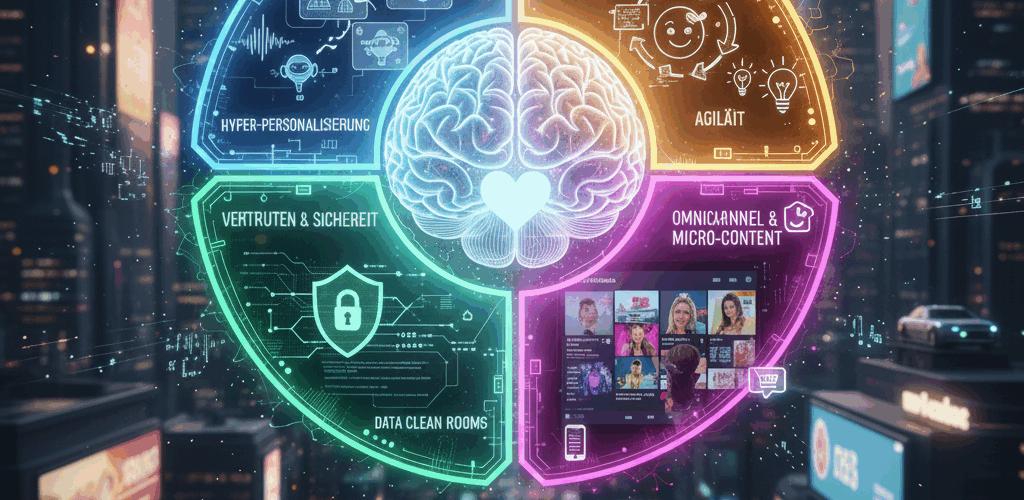EN
DE
NL
For those, who are not faliliar with the trem vibe marketing, hiere is an article about this topic: https://www.chatbase.co/blog/vibe-marketing
1. Agentic AI & Vibe Marketing: The autonomous team player
The next stage in the evolution of AI is Agentic AI systems. These autonomous AI agents go beyond pure automation: they can plan, make decisions and act proactively on behalf of the user independently.
- From tool to team member: Agentic AI transforms CRM from a pure data management system into an empathetic brand experience. AI acts as a valuable team player, taking on repetitive tasks and enabling human employees to focus on complex, emotional customer relationships. It is designed to support, not replace, human interaction.
- Vibe Marketing: Inspired by vibe coding (AI-driven software development through natural language), vibe marketing describes the AI-driven approach to creating emotional resonance in campaigns. AI automates execution to allow marketers to focus on strategy and brand identity.
- Hyper-personalisation: Agentic AI and predictive analytics enable customer communication on a hyper-personalised level. AI can anticipate needs and deliver tailored offers at the right moment without compromising privacy.
2. Design thinking: empathy as the basis for relevance
In this technology-driven world, people remain the focus. Design thinking is more than a method – it is an attitude that ensures innovations are truly relevant.
- The first step is empathy: only those who put themselves in the customer’s shoes and understand their needs, desires and pain points can create relevant offers. The integration of design thinking and (online) marketing makes it possible to develop campaigns that are highly resonant and measurable at the same time.
- Agility for creativity: Design thinking is a 100% agile process. Agility creates a culture of curiosity and experimentation, in which mistakes are seen as valuable learning moments. This is the basis for responding quickly to changing customer needs.
- AI accelerates design thinking: AI tools significantly accelerate the design thinking process. They provide support at every stage – from sentiment analysis (Empathise) to rapid idea generation (Ideate, e.g. through generative AI such as ChatGPT or Jasper) to automated A/B testing (Test).
3. Trust & security: The new conversion trigger
In times of ubiquitous cyber attacks, trust is the new conversion trigger. Loyalty arises when brands behave in a human, digital, empathetic and secure manner.
- Security by design: Security must be integrated into all CRM systems and processes from the outset, not added later.
- Transparency and plain language: Customers need to feel secure. Communication of security measures must be clear, understandable and proactive.
- Innovative approaches: New approaches are needed, such as combining agile, OKRs and design thinking in AI security tabletop exercises. Equally important are data clean rooms, which enable data protection-compliant collaboration without disclosing raw personal data.
4. Omnichannel & micro-content: The scroll experience
Shopping is becoming a scroll experience. Brick-and-mortar retail must transform, and marketing is becoming key to relevance, experience and trust.
- TikTok Commerce: Livestream shopping is establishing itself as a revenue engine, with authentic creators selling in real time and impulse purchases becoming a spectacle.
- Micro-content and storytelling: Short attention spans require micro-content (concise texts, images, short videos). Good stories and authentic storytelling create an emotional connection and convey brand values. UX texts are the ‘digital shop window’ that intuitively guides users through digital offerings and builds trust.
- O2O (online-to-offline): Brick-and-mortar retail must once again become an experience that arouses emotions. Marketing supports a seamless customer experience, with AI helping to bridge the gap between online and offline expectations.
Conclusion:
The future of marketing and e-commerce lies in the conscious combination of human attitude (empathy, creativity) and digital intelligence (agentic AI, automation). Companies that focus on agentic AI for hyper-personalised interactions, design thinking for user-centred innovation and security by design for trust will strengthen the loyalty of their customers in the long term.
‘CRM with character’ – digital, empathetic and secure – is the key to success in the era of D-commerce.
